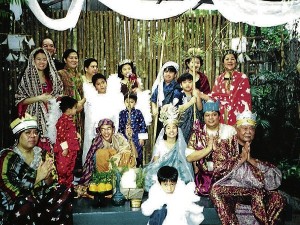
Lola put on her best hat with flowers and we buried the beloved in the backyard complete with candles and a bamboo cross on the burial mound. After that, Rafa was no longer a sad little boy.
Ritual is a ceremony (invented or not) which celebrates a significant event. Instead of a funeral hearse, a granduncle of my mother in Batangas was brought to the burial ground on the ornate four-poster bed on which he died, borne by several men. That was in the early 1900s. How can you beat such drama! But we try.
When I read the news that young painter-poet Maningning Miclat jumped to her death from the FEU building, my heart went out to the family, although I didn’t know them. My friend Mariel and I invented a Letting Go ritual for Mario and Alma Miclat and their daughter Banawe.
To join the ritual, we invited Ricky de Ungria, Maribel Ongpin, Karina Bolasco and Manny Chaves, who had at some time undergone a similar tragedy in their lives.
We burned incense in two clay pots perched on top of bamboo poles carried in by the maids. Bingbing Veloso had put a Maningning poem into song and sang it. Jim Paredes came with his guitar and sang sad songs.
We made a circle in the garden with the Miclats and the four other honorees. Each one who wished to, talked about their departed loved one. We wrote letters to the dead, saying what we had not been able to say to them in their lifetime. We burned the letters in a pot. It was a closure. It was very moving.
Quilts and ‘retazos’
There was no dialogue because no one was a good actor. The idea was always to just freeze the tableau and snap the Christmas pictures, quick, before everyone got fidgety. This went on until the last of the babies became too big for the manger and crawled out, almost falling off the stage.
After that we changed the costumes. I went to Pakil and ordered 18 pairs of large and small paper wings. From then on we were Christmas angels.
The quilts and sarongs and retazos served many other purposes. They became instant adult costumes for my friends when the Indonesian teacher, Prapto, came to visit Manila (see picture). We danced “free movement” using all the available cloths. Once we danced in the garden, snatching vines and flowers from everywhere. We drummed, we chanted, we cavilled in the moonlight. We had wild, unforgettable nights.
In our house, we welcomed every artwork that was delivered with a ritual. The biggest ones were Elmer Borlongan murals from floor to ceiling. My favorite, “Huntahan” or “Storytelling,” was recorded by a photographer from the time it was delivered by a van, until it was installed in the study.
We invited Elmer’s friends to a dinner to celebrate it. Myra Beltran danced and Coke Bolipata played his violin on a stone bench under a flowering tree.
When delivered, “Lumabat,” a Roberto Feleo sculpture with its arms outstretched, had its own welcome. Lumabat was a Bagobo god, so in his honor, we burned rock incense in different parts of the garden.
Lumabat hung on a branch of our dapdap tree for years until a typhoon crashed it on the adobe path. It was a terrible sight. Its jaw and one cheek were irreparably splintered and one foot cut off. It had been like a member of the family, so we gave it a proper burial in the garden under its late home, the dapdap tree.
Since Lumabat was a sculpture, its open arms could not be folded, so his grave is in the weird shape of a cross. Hundreds of years from now, when the lot is excavated for some future building, they will marvel at this starting artifact.
We started the Christmas rituals when my mother, Lola Nene, was still alive. I wonder when my children will be saying, “We started this when our mother (me) was still alive.”